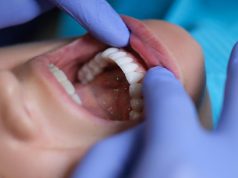Incidence dropped for cancers of lip, floor of mouth, soft palate and uvula, hard palate, hypopharynx, nasopharynx
FRIDAY, April 17, 2020 (HealthDay News) — From 2007 to 2016, the incidence of cancers of the oral cavity and pharynx combined increased, according to research published in the April 17 issue of the U.S. Centers for Disease Control and Prevention Morbidity and Mortality Weekly Report.
Taylor D. Ellington, M.P.H., from the CDC in Atlanta, and colleagues analyzed U.S. Cancer Statistics data to examine trends in the incidence of cancer of the oral cavity and pharynx by anatomic site, sex, race/ethnicity, and age group.
The researchers found that the incidence rates increased for cancers of the oral cavity and pharynx combined, base of tongue, anterior tongue, gum, tonsil, oropharynx, and other oral cavity and pharynx during 2007 to 2016. For cancers of the lip, floor of mouth, soft palate and uvula, hard palate, hypopharynx, and nasopharynx, the incidence rates declined. For cancers of the cheek and other mouth and salivary gland, the incidence rates were stable. The rates of all cancers of the oral cavity and pharynx combined increased for those aged 50 to 79 years, decreased for those aged 40 to 49 years, and remained stable for those aged 20 to 39 years and 80 years or older.
“The overall increase appears to be driven by increases in cancers of the tonsil, base of tongue, oropharynx, and other cancers of the oral cavity and pharynx, which are human papillomavirus-associated, as well as by those of gum and anterior tongue,” the authors write.
Copyright © 2020 HealthDay. All rights reserved.








